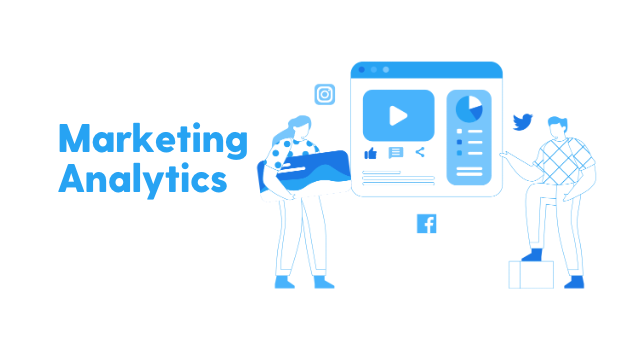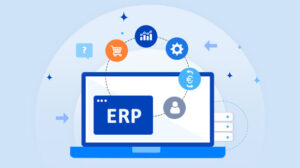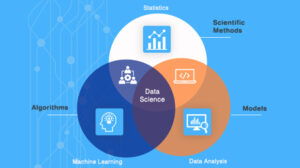Marketing analytics refers to the use of data, statistical analysis, and other quantitative tools to measure and analyze the effectiveness of marketing campaigns and tactics. It involves the collection, analysis, and interpretation of data to inform and improve marketing strategies. This can include metrics such as website traffic, lead generation, conversion rates, and customer lifetime value. The ultimate goal of marketing analytics is to optimize marketing campaigns and tactics to increase ROI and drive business growth.
Importance of Marketing Analytics in Today’s Business Landscape
In today’s fast-paced, data-driven business landscape, marketing analytics has become essential for companies to stay competitive. Marketing analytics allows companies to make data-driven decisions and track the effectiveness of marketing campaigns and tactics in real-time. By understanding how customers interact with their brand, companies can identify trends and patterns that can inform marketing strategies, helping them to reach new customers and increase sales.
Additionally, marketing analytics can also help companies identify areas of weakness in their marketing efforts and make adjustments to improve their ROI. It enables to make an informed decision with the evidence and insights, rather than assumptions. In today’s digital world, it’s crucial to have a data-driven approach to improve the customer journey, retain customers and drive growth for the business.
Five Types of Marketing Analytics
There are several different types of marketing analytics that companies can use to gain insights into their marketing efforts. Some of the most common types include:
- Descriptive analytics: This type of analytics involves looking at historical data to understand past performance. It can include metrics such as website traffic, conversion rates, and customer lifetime value. Descriptive analytics can help identify patterns and trends that can inform future marketing strategies.
- Diagnostic analytics: This type of analytics involves analyzing data to identify the causes of past performance. This can include metrics such as customer demographics, purchase history, and marketing campaign data. It can help to answer the question of why something happened in the past by doing a deep dive on the data.
- Predictive analytics: This type of analytics uses statistical modeling and machine learning to make predictions about future events. It can include metrics such as churn rate, lifetime value predictions, and predicted response to marketing campaigns. Predictive analytics can help companies to identify potential issues and opportunities before they happen and make more informed decisions.
- Prescriptive analytics: This type of analytics involves using advanced analytical techniques, such as operations research and decision science, to provide actionable recommendations and automating the decision-making process. It can include metrics such as identifying the optimal marketing mix, the best target segment, or the most effective pricing strategy.
- Real-time analytics: This type of analytics involves processing and analyzing data as it is generated, in near real-time. It can help a company to understand customer behavior and preferences as they happen, which in turn can inform marketing campaigns and adjust them on the fly.
It’s important to note that a company may use one or several of these types of analytics in their marketing efforts, and different types of analytics may be better suited for different types of business and goals.
8 Use-Cases for Marketing Analytics
Marketing analytics can be applied in a variety of ways to help companies improve their marketing strategies and drive business growth. Here are eight common use cases for marketing analytics:
- Customer segmentation: Marketing analytics can be used to segment customers based on demographic, behavioral, and psychographic data, in order to better target specific groups of customers with personalized marketing campaigns.
- Campaign optimization: By analyzing metrics such as website traffic, conversion rates, and customer lifetime value, companies can optimize their marketing campaigns to better reach their target audiences and increase ROI.
- Lead generation and nurturing: Marketing analytics can be used to identify the most effective channels and tactics for generating leads, as well as to track the performance of lead nurturing campaigns.
- Personalization: Marketing analytics can be used to personalize the customer journey, messaging, and offers, resulting in better engagement and conversion rates.
- Marketing Mix Optimization: Companies can use marketing analytics to optimize their marketing mix by allocating their marketing budget in the most effective way and identifying the optimal combination of product, price, promotion and distribution channels.
- Predictive modeling: Marketing analytics can be used for predictive modeling to forecast future customer behavior, sales, or revenue, allowing companies to proactively plan for future growth and make informed decisions.
- Attribution modeling: Marketing analytics can be used for attribution modeling to understand which marketing channels and activities are driving conversions, enabling companies to measure the effectiveness of each channel and attribute revenue to the correct source. Read more – Marketing Attribution
- Social Media analytics: Companies can use marketing analytics to analyze social media data, like engagement rates, follower demographics and sentiment analysis to gain insights on their social media performance and understand customer preferences.
Marketing Data and Metrics
Marketing data and metrics refer to the quantitative information and measurements that businesses use to evaluate the effectiveness of their marketing campaigns and strategies. This information can include metrics like website traffic, conversion rates, customer acquisition costs, and return on investment (ROI).
Also, read:
Role of Data in Marketing Analytics
Data plays a critical role in marketing analytics, as it is used to inform business decisions, measure the performance of marketing campaigns, and identify opportunities for improvement.
One of the key ways that data is used in marketing analytics is to measure the performance of marketing campaigns. By tracking key performance indicators (KPIs) such as website traffic, conversion rates, and return on investment (ROI), businesses can gain a better understanding of which marketing efforts are most effective, and which areas may require improvement.
Data can also be used to identify patterns and trends in customer behavior. For example, businesses can use data on customer demographics, purchase history, and website interactions to segment their customer base and target their marketing efforts more effectively. By analyzing this data, businesses can gain insights into what types of products and services are most popular with different segments of their customer base, and use this information to inform their product development and marketing strategies.
Additionally, Data also plays a crucial role in forecasting future performance. By analyzing historical data and identifying patterns, businesses can make predictions about future trends, such as how sales may change during the different seasons of the year, and how they are likely to be impacted by external factors like changes in the economy.
Moreover, data can also be used to evaluate the effectiveness of different marketing channels. For example, businesses can use data on website traffic and conversion rates to compare the performance of their search engine optimization (SEO) efforts against their social media marketing campaigns. This can help them identify which channels are driving the most traffic and conversions, and make informed decisions about where to allocate their marketing budget in the future.
Also, read:
Measuring Marketing ROI
Measuring the return on investment (ROI) of a marketing campaign is an important way for businesses to evaluate the effectiveness of their marketing efforts and make data-driven decisions about where to allocate their resources.
To measure the ROI of a marketing campaign, businesses typically use the following formula:
ROI = (Revenue from campaign – Cost of campaign) / Cost of campaign
In this formula, revenue is the total amount of money generated by the campaign, and the cost is the total amount of money spent on the campaign, including expenses such as advertising, promotions, and labor.
It’s important to note that, to calculate ROI accurately, you should track not only the direct costs but also any indirect costs such as overheads, opportunity costs or other hidden costs of the campaign that may be part of the budget.
Additionally, to get the most accurate measurement of ROI, it is important to track and measure the performance of the campaign over an appropriate period of time. For example, if you are tracking sales, it can take longer than a week or a month to see the effects of a marketing campaign and it might require more time to see if the changes are due to the campaign or the seasonality of the business.
ROI can be used to evaluate the performance of a wide range of marketing campaigns, including traditional campaigns such as TV and print ads, as well as digital campaigns such as social media marketing and email marketing. Additionally, by comparing the ROI of different campaigns, businesses can identify which campaigns are most effective in terms of generating revenue and making the most efficient use of their marketing budget.
It’s also worth mentioning that while ROI is an important metric to track, it’s not the only metric that should be considered when evaluating marketing efforts. For example, other metrics like customer lifetime value, customer acquisition cost, retention rate, engagement rate can also be valuable in evaluating the effectiveness of different marketing strategies.
Overall, measuring marketing ROI is an essential part of making data-driven decisions about marketing strategies and allocating marketing resources efficiently. It helps businesses understand which marketing efforts are delivering the greatest return on investment and which areas of their marketing efforts they need to improve.
Also, read:
Understanding Customer Lifetime Value
Customer lifetime value (CLV) is a metric that businesses use to estimate the total value that a customer will bring to a company over the course of their lifetime. This metric is important for businesses because it helps them understand the long-term value of acquiring and retaining customers, and can inform decisions about customer acquisition and retention strategies.
There are a few different ways to calculate CLV, but the most common method is to use the following formula:
CLV = (Average Revenue per Customer) x (Customer Retention Rate) x (Average Customer Lifetime)
In this formula, the average revenue per customer is the average amount of money that a customer spends on products or services over a given period of time. The customer retention rate is the percentage of customers who remain loyal to a company over a given period of time. And the average customer lifetime is the average amount of time that a customer remains a customer of a company.
To calculate CLV, you need to have data on customers’ purchases and retention rate over a certain period of time. However, this data could be limited, especially if the business is new, it’s hard to predict customer lifetime based on a short period of time. In this case, some businesses prefer to use estimated or industry-average values for these factors.
Once a business has calculated CLV, it can use this metric to inform a variety of business decisions. For example:
- By understanding the CLV of different customer segments, a business can prioritize acquiring and retaining the most valuable customers.
- A business can use CLV to determine how much it can afford to spend on customer acquisition campaigns, such as advertising and promotions, while still generating a positive return on investment.
- A business can use CLV to determine the value of implementing retention strategies, such as loyalty programs, to encourage repeat business from existing customers.
- A business can use CLV to identify areas where it can improve customer retention, such as by improving the customer experience or addressing customer complaints.
It’s important to note that CLV is a forward-looking metric and estimates are made based on certain assumptions, so it should be considered a guide rather than an absolute value. Additionally, it’s also important to track and monitor customer lifetime value over time to see how it changes and improve the accuracy of the estimation.
Also, read:
9 Key Metrics for Measuring Marketing Effectiveness
Measuring the effectiveness of marketing campaigns is important for businesses to understand the return on their investment and make data-driven decisions about future marketing strategies. There are many different metrics that businesses can use to measure the effectiveness of their marketing campaigns, but nine key metrics include:
- Return on Investment (ROI): This metric measures the profitability of a marketing campaign, calculated by dividing the revenue generated by the campaign by the cost of the campaign.
- Customer Acquisition Cost (CAC): This metric measures the cost of acquiring a new customer, calculated by dividing the total cost of sales and marketing efforts by the number of new customers acquired.
- Lifetime Value (LTV): This metric estimates the total value that a customer will bring to a company over the course of their lifetime.
- Conversion Rate: This metric measures the percentage of website visitors who take a desired action, such as making a purchase or filling out a contact form.
- Website Traffic: This metric measures the number of visitors to a website, and can be broken down by various segments such as geographic location, referral source, and device type.
- Click-through Rate (CTR): This metric measures the percentage of people who click on a link or ad after seeing it, It’s a good way to understand the relevance and effectiveness of ad or campaigns.
- Bounce Rate: This metric measures the percentage of people who leave a website after only viewing a single page. High bounce rates may indicate that the website or landing page is not providing the information or experience that visitors are looking for.
- Engagement: This metric measures how much time people spend on a website, and how much they interact with the content. engagement rate can be calculated by dividing the total number of engagements by the total number of impressions.
- Social Media metrics: For social media campaigns, metrics such as likes, shares, followers, and comments can be used to track engagement and the reach of the campaign.
Advanced Marketing Analytics Techniques
Advanced marketing analytics techniques are methods used to extract insights from large and complex datasets to inform business decisions. These techniques can help businesses gain a deeper understanding of customer behavior and preferences, optimize marketing campaigns, and predict future trends. Here are six examples of advanced marketing analytics techniques:
- Predictive modeling: This technique uses historical data to build models that can predict future outcomes, such as customer purchasing behavior or response to a marketing campaign. Machine learning algorithms like decision trees, random forests and gradient boosting methods can be used for this purpose.
- Natural Language Processing (NLP): This technique is used to extract insights from unstructured data sources such as social media posts, customer reviews, or survey responses. NLP algorithms can be used to analyze the sentiment of the text, classify it into categories, and extract key topics and entities.
- Churn analysis: Churn analysis is used to identify customers who are at risk of leaving a company and to predict which customers are most likely to churn. This technique can be used to target retention and upselling campaigns to high-risk customers.
- Cohort analysis: This technique is used to analyze the behavior of groups of customers who have similar characteristics, such as acquisition date or product usage. Cohort analysis can help businesses understand how customer behavior changes over time, and identify trends and patterns in customer behavior.
- A/B testing: This technique is used to compare the performance of two or more variations of a marketing campaign to see which one is more effective. For example, an A/B test could be used to compare the performance of two different email subject lines, or two different versions of a landing page.
- Attribution Modeling: Attribution modeling is used to determine the relative contribution of different touchpoints in the customer journey, like online and offline media, and different stages of the funnel, like awareness, consideration and conversion. Based on this, businesses can allocate the budget to the most effective touchpoints, optimize the funnel and improve their marketing pe
Predictive Analytics in Marketing
Predictive analytics is a type of advanced analytics that uses historical data and statistical models to make predictions about future outcomes. In marketing, predictive analytics can be used to identify patterns and trends in customer behavior and predict how customers are likely to respond to different marketing campaigns and strategies.
There are several key applications of predictive analytics in marketing:
- Customer Segmentation: Predictive analytics can be used to segment customers into different groups based on their characteristics and behavior, such as their purchase history or demographics. This can help businesses target their marketing efforts more effectively, by tailoring campaigns and messaging to specific customer segments.
- Churn prediction: Predictive analytics can be used to identify customers who are at risk of leaving a company, which is known as “churn.” By identifying high-risk customers early, businesses can target retention campaigns to try to keep them from leaving.
- Lead scoring: Predictive analytics can be used to score leads based on their likelihood of becoming customers. This can help businesses prioritize their sales efforts by focusing on leads that are most likely to convert.
- Next-best-offer: Predictive analytics can be used to predict which products or services a customer is most likely to be interested in, based on their purchase history, demographics, and other data. This can be used to create personalized offers for each customer, increasing the chances of them making a purchase.
- Lifetime Value prediction: Predictive analytics can be used to predict how much a customer is likely to spend over their lifetime, which is known as customer lifetime value. Knowing the lifetime value of a customer can help businesses make informed decisions about how much to invest in acquiring and retaining that customer.
Predictive analytics in marketing is mainly based on Machine Learning algorithms like Decision trees, Random Forests, Gradient Boosting and Neural Networks. These algorithms are trained on historical data and then make predictions based on new data that is fed to the model.
To be effective, predictive analytics in marketing requires a large amount of high-quality data and a skilled team with expertise in data science, statistical analysis, and machine learning. But when it’s implemented correctly, it can give a business a competitive edge by providing insights that can inform decisions about customer acquisition, retention, product development and marketing.
Building a Recommendation Engine
Building a recommendation engine can be a challenging task, but there are a few basic steps you can follow to get started. Here’s a high-level overview of the process:
- Collect and prepare your data: This includes gathering information on users, items, and any interactions between them (e.g. user ratings on items). It also involves cleaning and pre-processing the data to ensure that it’s in a format that can be used by your model.
- Choose a model: There are many different types of recommendation models, each with their own strengths and weaknesses. Some popular choices include collaborative filtering, content-based filtering, and hybrid models. It depends on your data and your needs, the choice of model can be varied.
- Train the model: Once you’ve chosen a model, you’ll need to train it on your data. This typically involves using a training dataset to optimize the model’s parameters so that it can make accurate predictions.
- Evaluate the model: After training, you’ll need to evaluate the model to see how well it’s able to make recommendations. This can be done using metrics such as precision, recall, and mean average precision.
- Optimize and Deploy: Based on the evaluation metrics you can fine-tune your model to achieve better performance. Once your model is performing well, you can deploy it to a production environment where it can be used to make recommendations to real users.
Keep in mind that this is just a high-level overview and there are many details to consider when building a recommendation engine. Additionally, There are many libraries, frameworks and pre-trained models available that can make the task a lot easier.
Using Machine Learning to Optimize Marketing Campaigns
Using machine learning (ML) to optimize marketing campaigns can be a powerful way to improve their effectiveness and efficiency. Here are a few ways that ML can be used in marketing:
- Personalization: ML can be used to personalize marketing messages and offers to individual customers, based on their behavior, demographics, and other factors. For example, a company might use ML to create a personalized email campaign that targets customers with tailored promotions based on their purchase history.
- Optimizing marketing spend: ML can be used to optimize marketing budgets by identifying which marketing channels and tactics are most effective for reaching and converting customers. For example, an e-commerce company might use ML to analyze which sources are driving the most sales, and then allocate more of their budget to those channels.
- Customer Segmentation: Machine learning models can help in building clusters of customer with similar characteristics and behaviours that can be targeted with specific campaigns. This can help to increase the conversion rate.
- Optimizing the customer journey: Machine learning models can analyze the customer behavior and predict the next action customer would take in the journey. Based on this, the companies can optimize the customer journey for better conversion.
Also, read:
Personalizing Marketing Efforts with AI
Personalizing marketing efforts with artificial intelligence (AI) can be a powerful way to improve customer engagement and conversion rates. Here are four ways that AI can be used to personalize marketing efforts:
- Personalized product recommendations: AI can be used to analyze customer behavior and preferences, and then recommend products or services that are likely to be of interest. For example, an e-commerce website might use AI to recommend products to customers based on their browsing history or purchase history.
- Personalized email campaigns: AI can be used to personalize email campaigns by targeting specific customer segments with tailored messages. For example, a company might use AI to send personalized product recommendations to customers based on their purchase history, or to send personalized coupons to customers who have abandoned their shopping cart.
- Personalized content: AI can be used to personalize website content, social media posts, or advertisements for specific customer segments. For example, a news website might use AI to recommend articles to readers based on their reading history or to show personalized ads based on their browsing history.
- Chatbots: AI-powered chatbots can be used to provide personalized customer service. These chatbots can interact with customers via messaging apps, websites, or mobile apps, providing information and assistance in real-time. The conversations can be further personalized based on the customer data and previous interactions.
AI-powered personalization can be complex and requires specialized knowledge and technology. It also requires a significant amount of data to train models and make accurate predictions. But with the right approach and resources, personalizing marketing efforts with AI can provide a significant return on investment.
Data Visualization and Reporting
Data visualization and reporting is essential understanding and communicating the results of marketing analytics. They can help marketers make data-driven decisions and effectively communicate results to stakeholders. Here is an overview of five key aspects related to data visualization and reporting in marketing analytics:
- The importance of data visualization in marketing analytics: Data visualization is important in marketing analytics because it allows marketers to quickly and easily understand and communicate large amounts of data. It can be used to identify trends, patterns, and insights in data, and to communicate these insights to stakeholders concisely.
- Creating effective dashboards: Dashboards are a powerful tool for data visualization and reporting in marketing analytics. They can be used to display key metrics and performance indicators, and to allow marketers to monitor the results of their campaigns in real-time. To create effective dashboards, it’s important to focus on the key metrics that are most important for your business, to choose appropriate visualization types and make it easy to use and understand.
- Tips for effective data visualization: Four tips for effective data visualization in marketing analytics include:
- Using appropriate visualization types for the data and message you want to convey
- Keeping visualizations simple and easy to understand
- Using colors and other design elements to highlight important information
- Making sure visualizations are accurate and convey the correct message
- Best practices for data reporting: Four Best practices for data reporting in marketing analytics include:
- Clearly defining the objectives of the report
- Choosing the right metrics and indicators to measure performance
- Using a consistent format for data representation across different reports
- Making sure the reports are easy to understand and actionable
- Data storytelling in marketing: Data storytelling is the process of using data, visualization, and narrative to communicate a message or insights to stakeholders. In marketing analytics, data storytelling can be used to effectively communicate the results of campaigns and other marketing efforts. To create effective data stories, it’s important to choose the right data, select meaningful insights, use clear and engaging visuals and create a compelling narrative.
Ethics and Governance in Marketing Analytics
As with any field that relies on data, there are ethical and governance issues to consider.
- Understanding bias in algorithms: Algorithms can inadvertently introduce bias, leading to unfair or discriminatory outcomes. It’s important to ensure that data sets used to train algorithms are diverse and representative, and to regularly test and monitor algorithms for bias.
- Balancing personalization and privacy: Personalization can improve the customer experience and lead to increased conversions, but it also raises privacy concerns. Companies need to strike a balance between using data to personalize the customer experience and protecting customer privacy. One way to do this is by being transparent about data collection and use, and giving customers control over their data.
- Marketing analytics and GDPR compliance: The General Data Protection Regulation (GDPR) is a set of regulations in the EU that regulates the collection, storage, and use of personal data. Companies need to ensure that their marketing analytics practices are compliant with the GDPR, including obtaining consent for data collection and providing individuals with the right to access, delete, and control their personal data.
- Best practices for data governance in marketing: Data governance is the process of managing data to ensure that it is accurate, consistent, and compliant with regulations. Some best practices for data governance in marketing include establishing a clear data ownership structure, regular data audits, and implementing data management processes such as data quality checks and data lineage tracking.
- Ethical considerations in data-driven marketing: The use of data in marketing raises a number of ethical considerations, such as privacy, transparency, and fairness. Companies should consider these issues when developing data-driven marketing strategies, and establish clear ethical guidelines for data usage. It’s also important to consider the impact of your decisions on different societal groups or demographic.
Conclusion
As technology advances, the capabilities of marketing analytics will continue to expand. Machine learning and artificial intelligence will allow for more advanced analysis and prediction, while the growth of data sources such as social media and connected devices will provide more data to analyze. Additionally, technologies such as blockchain may offer new possibilities for securing and sharing data, while also giving customers more control over their data.
Marketing analytics can help businesses make data-driven decisions that lead to increased conversions and revenue. For example, by analyzing data on customer behavior and preferences, businesses can personalize marketing campaigns and improve the customer experience. Additionally, marketing analytics can help businesses identify new opportunities for growth and make better use of their resources.
Investing in marketing analytics can help businesses grow, but it’s important to have the right data foundation and team in place. Saras Analytics’ 1-1-1 framework is a way for businesses to invest in marketing analytics by committing 1% of their revenue for 1 year and having our managed data service as the single point of contact for all data needs. This will help businesses to get the most out of their analytics investments and drive non-linear growth.













